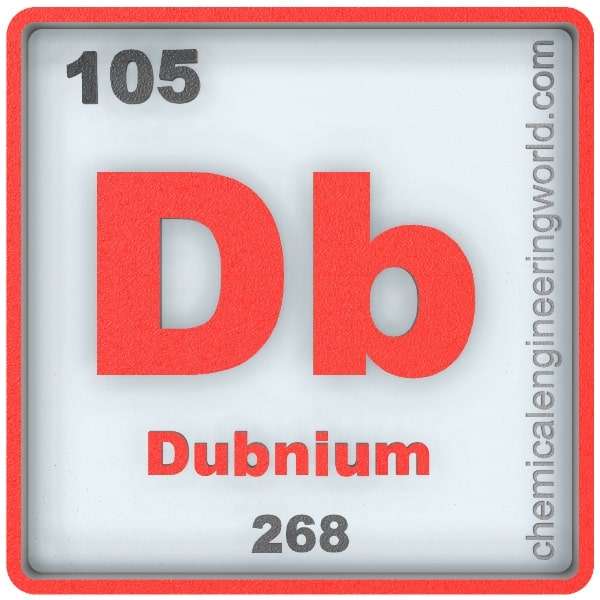Dubnium Element Properties and Information

Dubnium Element Properties and Information
Dubnium is 105th element on the periodic table. Elements are arranged in the periodic table on the basis of the atomic number. Atomic number is the number of protons in the nucleus of the atom. Dubnium has an atomic number of 105. It is located in the Group 5 and Period 7 of the periodic table of elements and denoted by the symbol ‘Db’. Dubnium is named after Dubna, a Russian town.
The element-105 was discovered in 1968 by a team led by Georgy Flerov at Joint Institute for Nuclear Research (JINR). The isotope-261 of the element-105 was made by a team led by Albert Ghiorso at the Lawrence Berkeley Laboratory (LBL) in 1970. Both of the teams initially gave different names to the element-105; the JINR group called it neilsbhorium and the LBL group called it hahnium; both named after prominent scientists. Eventually, the International Union of Pure and Applied Chemistry (IUPAC) decided it should be called Dubnium. Dubnium does not occur naturally in Earth’s crust; it can only be prepared in a synthetic manner in particle accelerators. It cannot even be prepared in a nuclear reactor. All the isotopes of Dubnium which have been characterized so far have been obtained synthetically.
Physical Properties
- Dubnium is a synthetic element which is quite difficult to characterize.
- The atomic mass of the dubnium is 261.9.
- The melting point of dubnium is unknown as of yet.
- The boiling point of dubnium is unknown as of yet.
- The density of dubnium is unknown as of yet.
- The longest lived isotope of dubnium has a half-life of 28 hours; this makes its estimation of properties very difficult. So far, studies have only been performed on single atoms.
- The atoms of the solid state dubnium is are expected to arrange themselves in body-centered cubic structure.
- The isotopes which have relatively long half-life are much harder to produce; this also poses challenge in the study of dubnium.
Chemical Properties
- The chemical properties have only been studied theoretically and some of the properties have been verified in single-atom experiments.
- Calculations of solution chemistry indicate that the dubnium compounds which display an oxidation state of ‘+5’ are much more stable than those which display states of ‘+2’ and ‘+3’.
- Calculations in solution chemistry also dictate that the dubnium compounds which display an oxidation state of ‘+5’ are relatively more stable than niobium and tantalum compounds of the same state.
- The complexion tendency and ability of dubnium is expected to be similar to the group-5 elements.
Methods of Production
Particle Accelerator: All the elements which have atomic number greater than 100 can only be prepared through reactions in a particle accelerator such as a cyclotron; they are not formed in a nuclear reactor. Californium-249 is bombarded with neutrons to form dubnium; it captures 15 neutrons to form dubnium-260.
Relevance in Chemical & Related Industries
Dubnium has no relevant use in chemical & related industries.
Relevance in Other Industries
Research: Dubnium has relevance only in the field of research.
Health Effects on Exposure
Dubnium doesn’t occur naturally hence there is no reason to study its effects on health.
Effects on Surroundings
Dubnium does not occur in Earth’s crust hence there is no reason to study its effects on environment.
References:
https://en.wikipedia.org/wiki/Dubnium
https://www.lenntech.com/periodic/elements/db.htm































